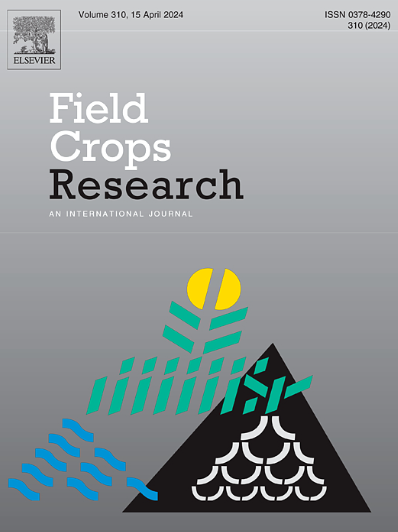玉米秸秆还田促进高密度木薯-玉米间作系统细菌介导的养分循环和产量恢复
IF 5.6
1区 农林科学
Q1 AGRONOMY
引用次数: 0
摘要
高密度木薯玉米间作(HDCMI)在提高土地利用效率方面已被证明是有效的。然而,与单作相比,共生期间产生的种间竞争往往会降低木薯或玉米的产量。目的探讨玉米秸秆还田HDCMI系统解决上述问题的潜力。该方法强调可能改善土壤养分循环和有益微生物群落。方法采用木薯单作(C)、玉米单作(M)、木薯-玉米间作不秸秆还田(CM)和木薯-玉米间作玉米秸秆还田(CMr) 4种处理进行田间试验。评估内容包括作物生长、产量、土壤化学性质以及根际、非根际和行间土壤的微生物多样性。包括共现网络分析、Mantel检验、偏最小二乘路径模型(PLS-PM)在内的先进技术阐明了土壤养分、细菌网络模块与木薯产量之间的关系。结果间作使玉米产量降低10.13 % (P = 0.03),对共生期木薯生长造成暂时抑制;然而,木薯在玉米收获后恢复。虽然HDCMI系统的土地当量比(LER)为1.86,但木薯产量与单一栽培处理相比下降了6.62 % (P = 0.02)。与CM处理相比,CMr处理使木薯产量(P = 0.024)和贮藏根氮积累(P = 0.018)分别提高了6.5 %和24.22 %,使产量恢复到单作时的水平。CMr还增加了土壤有机质,改善了养分循环,提高了木薯组织氮钾积累;氮的影响最为明显。细菌分析表明,CMr提高了土壤微生物α-多样性,增加了分枝杆菌、慢生根瘤菌、IMCC26256、WPS-2和芽孢杆菌等有益菌。此外,网络分析表明,玉米秸秆还土通过抑制模块2 (P >; 0.05)和模块4 (P = 0.024)促进了氮相关分类群(如Candidatus Solibacter, IMCC26256)的生长。这些调整促进了木薯根际氮的转移和利用。结论玉米秸秆还田HDCMI系统通过改变细菌网络提高土壤氮素有效性,最终支持木薯养分吸收和产量形成。本研究促进了对玉米秸秆还田木薯间作系统氮素效率策略的认识,为养分效率型农业生态系统管理提供依据。本文章由计算机程序翻译,如有差异,请以英文原文为准。
Bacterial-mediated nutrient cycling and yield recovery in high-density cassava–maize intercropping systems enhanced by maize straw return
Background
High-Density Cassava-Maize Intercropping (HDCMI) has been proven effective in improving land-use efficiency. However, interspecific competition arising during the symbiotic period often reduces cassava or maize yields compared with monocropping.
Objective
This study explored the potential of the HDCMI system with maize straw return to address these challenges. The approach emphasized possible improvements in soil nutrient cycling and beneficial microbial communities.
Methods
Field experiments involved four treatments: cassava monoculture (C), maize monoculture (M), cassava-maize intercropping without straw incorporation (CM), and cassava-maize intercropping with maize straw return (CMr). The assessments covered crop growth, yield, soil chemical properties, and microbial diversity in rhizosphere, non-rhizosphere, and inter-row soils. Advanced techniques, including co-occurrence network analysis, Mantel tests, partial least squares path modeling (PLS-PM), clarified the relationships among soil nutrients, bacterial network modules, and cassava yield.
Results
Intercropping resulted in an 10.13 % reduction (P = 0.03) in maize yield and caused a temporary suppression of cassava growth during the symbiotic period; however, cassava recovered following maize harvest. Although the HDCMI system achieved a land equivalent ratio (LER) of 1.86, cassava yield declined by 6.62 % (P = 0.02) compared with the monoculture treatment. In comparison with CM, the CMr treatment boosted cassava yield (P = 0.024) and nitrogen accumulation in storage roots (P = 0.018) by 6.5 % and 24.22 %, respectively, which restored yield to levels observed in the monoculture. CMr also increased soil organic matter, improved nutrient cycling, and raised nitrogen/potassium accumulation in cassava tissues; nitrogen effects were the most pronounced. Bacterial analysis revealed that CMr promoted soil microbial α-diversity and enriched beneficial genera such as Mycobacterium, Bradyrhizobium, IMCC26256, WPS-2, and Bacillus. Furthermore, network analysis demonstrated that maize straw return facilitated nitrogen-related taxa (e.g., Candidatus Solibacter, IMCC26256) by suppressing Modules 2 (P > 0.05) and 4 (P = 0.024). These adjustments promoted nitrogen transfer and utilization in the cassava rhizosphere.
Conclusions
The HDCMI system with maize straw return enhances soil nitrogen availability through modifications in bacterial networks, ultimately supporting cassava nutrient absorption and yield formation.
Significance
This study advances the understanding of nitrogen-efficient strategies in cassava intercropping systems with maize straw return, providing a basis for nutrient-efficient agroecosystem management.
求助全文
通过发布文献求助,成功后即可免费获取论文全文。
去求助
来源期刊

Field Crops Research
农林科学-农艺学
CiteScore
9.60
自引率
12.10%
发文量
307
审稿时长
46 days
期刊介绍:
Field Crops Research is an international journal publishing scientific articles on:
√ experimental and modelling research at field, farm and landscape levels
on temperate and tropical crops and cropping systems,
with a focus on crop ecology and physiology, agronomy, and plant genetics and breeding.
 求助内容:
求助内容: 应助结果提醒方式:
应助结果提醒方式:


